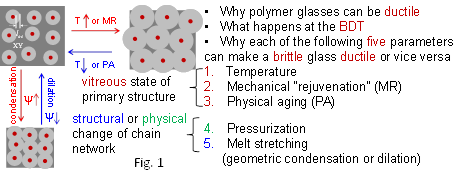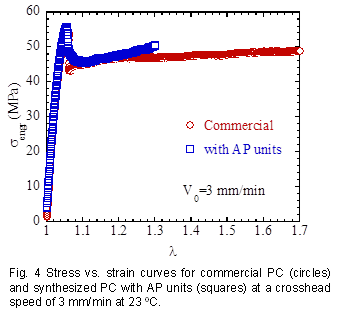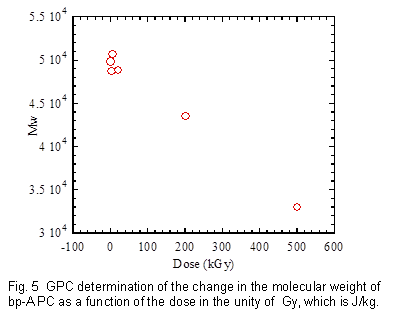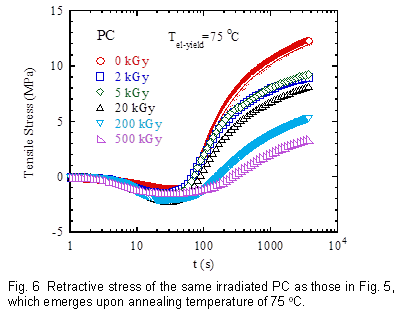Reports: ND754047-ND7: Elucidate the Molecular Orgins of Mechanical Stress in Large Deformations of Polymer Glasses by Incorporating Chromophores into the Backbone as Molecular Probes
Abraham Joy, University of Akron
Shi-Qing Wang, University of Akron
Significant progress has been made toward a qualitative illustration of the molecular origin of stress arising from large ductile deformation of polymer glasses. In particular, we made a breakthrough in our conceptual understanding of various aspects of mechanical behavior including yielding and brittle-to-ductile transition (BDT). The proposed model has advanced our theoretical description to answer important questions such as why polymer glasses can be ductile and undergo plastic flow, why polystyrene (PS) is extremely brittle but bisphenol A polycarbonate (bp-A PC) is very ductile, why PS is brittle in extension but ductile in compression. The PRF funding has resulted in several publications including a chapter in an upcoming book. Given the considerable success related to the PRF support, we are now well prepared to move forward towards our goal, which is to establish molecular mechanics of polymer glasses as a vibrant field in polymer science.
During the funding period, a foundational study emerged from a previously published notion (shown in TOC) of structural hybrid for polymer glasses. It has provided the grounds for the proposed research and can be summarized as shown in Fig. 1. In particular, Fig. 1 summarizes how the molecular model rationalizes the effects of aging or mechanical rejuvenation and melt stretching (to produce geometric condensation) or dilution by short chains on the mechanical responses. The new picture leads to two important findings made during the funding period that are described briefly as follows.
We discovered re-entrance of brittle-like behavior when the applied extensional rate decreases. Fig. 2 shows the tensile responses of PMMA at 35 oC to five different rates ranging from the highest 18 to lowest 0.002 min-1. Strikingly, PMMA is most ductile and draws uniformly at the intermediate rates of 2 and 0.2 min-1 and turns brittle like again at the lower rates. For yielding and plastic flow to take place, the glassy dynamics necessarily need to speed up to match the imposed rate. Thus, according to the conventional wisdom, polymer glasses is always more brittle at higher extensional rates. No literature data contradict this statement until the discovery of Fig. 2. This non-monotonic response sets stringent constraints on any theoretical picture for yielding and failure of polymer glasses and is therefore an excellent test for the emergent molecular model. PS was found to behave similarly.
Since loading elements are in parallel for compression unlike extension where they are in series, stress can still rise upon brittle failure during uniaxial compression. Little information is available in the literature to demonstrate brittle failure in compression because polymer glasses under examination were typically not of sufficiently low molecular weight. Fig. 3 shows that PS with Mw = 45 kg/mol is very brittle in compression at an apparent rate of 1 min-1. However, upon incorporating PS with Mw = 319 kg/mol into PS45K, the binary mixture PS(45:319) containing 40 % PS45K and 60 % PS319K is ductile, yielding at 6 % and subsequently undergoing plastic compression.
Data in Fig. 2 and Fig. 3 require us to envision yielding and failure of polymer glasses to be controlled by the characteristics of the chain network embedded in the vitreous medium. A more direct piece of evidence to indicate the intra-segmental origin of mechanical stress can be obtained from the observation of elastic yielding: A cold drawn polymer glass, during annealing at a higher temperature than the storage and cold drawing temperatures, would display retractive stress whose origin should be intra-segmental and elastic. The proposed research aims to elucidate that chain networking is important for ductility by determining whether the effect of elastic yielding diminishes if a pre-cold drawn polymer glass undergoes chain scission.
As described in the proposal, bp-A PC copolymerized with the photocleavable moiety alkoxyphenacyl diol (AP) was synthesized. We were able to incorporate the AP unit into the polycarbonate and obtained polycarbonates in the range of Mn 25,000. However it was determined that these molecular weights were too low to show ductile behavior in extension. As shown in Fig. 4, the synthesized PC with AP units cannot be stretched as long as commercial one, which makes it difficult to study the elastic yielding behavior. Attempts to fractionate the obtained polymers did not significantly increase the Mw to be useful for the mechanical tests.
Therefore we applied an alternative method to cause chain scission in the pre-necked bp-A PC in a non-invasive manner i.e., to subject the pre-extended polymer to different doses of Gamma irradiation. Fig. 5 confirms that the molecular weight of bp-A PC decreases with increasing dose of Gamma irradiation. Such degradation by the irradiation is expected to lower the embedded chain tension. To test this idea, these irradiated samples were taken to convenient annealing temperatures to produce elastic yielding. Fig. 6 shows that the retractive stress significantly decreases in magnitude with increasing dosage of the Gamma irradiation.
We are also currently evaluating the incorporation of AP moieties into PLGA polyesters. This will enable us evaluate a polyester in which only the photoactive moiety absorbs the light unlike bp-A PC. The incorporation of the AP moieties may also raise Tg of the polyester thereby enabling successful tensile extension of these polymers. We are currently optimizing the synthesis of such polymers.
The research has provided training opportunities for two graduate students, allowing them to enter a promising and fast development field in polymer science. The research was part of the activity that led to the proposal of a new molecular model for yielding and failure behavior of polymer glasses. Thus, it has profoundly influenced the Pi and co-PI's research direction.

















